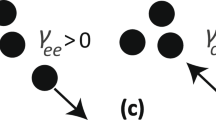Abstract
“Chases and escapes” is a traditional mathematical problem. The act of balancing a stick on human fingertips represents an experimental paradigm of typical “one-to-one” chase and escape. Recently, we have proposed a simple model where we extend the chaser and escape to a case a group of particles chasing another group, called “group chase and escape.” This extension connects the traditional problem with current interests on collective motions of animals, insects, vehicles, etc. In this chapter, we present our basic model and its rather complex behavior. In the model, each chaser approaches its nearest escapee, while each escapee steps away from its nearest chaser. Although there are no communications within each group, simulations show segregations of chasers and targets. Two order parameters are introduced to characterize the chasing and escaping in group. Further developments are reviewed to extend our basic model.
Access this chapter
Tax calculation will be finalised at checkout
Purchases are for personal use only
Similar content being viewed by others
References
Angelani L (2012) Collective predation and escape strategies. Phys Rev Lett 109:118104
Bando M, Hasebe K, Nakayama A, Shibata A, Sugiyama Y (1995) Dynamical model of traffic congestion and numerical simulation. Phys Rev E 51:1035
Bulsara AR, Gammaitoni L (1996) Tuning in to noise. Phys Today 49:39
Gammaitoni L, Hanngi P, Jung P, Marchesoni F (1998) Stochastic resonance. Rev Mod Phys 70:223
Isaacs R (1965) Differential games. Wiley, New York
Iwama T, Sato M (2012) Group chase and escape with some fast chasers. Phys Rev E 86:067102
Kamimura A, Ohira T (2010) Group chase and escape. New J Phys 12:053013
Kamimura A, Matsumoto S, Nogawa T, Ito N, Ohira T (2011) Stochastic resonance with group chase and escape. In: 2011 21st international conference on noise and fluctuations (ICNF). Stochastic resonance with group chase and escape. Toronto, p 200
Matsumoto S, Nogawa T, Kamimura A, Ito N, Ohira T (2011) Dynamical aspect of group chase and escape. AIP Conf Proc 1332:226
Nahin PJ (2007) Chases and escapes: the mathematics of pursuit and evasion. Princeton University Press, Princeton
Nishi R, Kamimura A, Nishinari K, Ohira T (2012) Group chase and escape with conversion from targets to chasers. Physica A 391(1–2):337
Ohira T, Sawatari R (1998) Phase transition in a computer network traffic model. Phys Rev E 58:193
Ohira T, Kamimura A, Milton JG (2011) Pursuit-escape with distance-dependent delay. In: 7th European nonlinear dynamics conference (ENOC2011), Pursuit-escape with distance-dependent delay. Rome, MS-11
Reynolds CW (1987) Computer Graphics, 21(4)(SIGGRAPH ’87 conference proceedings), 25
Rucle WH (1991) A discrete search game. In: Raghavan TES et al (eds) Stochastic games and related topics. Kluwer Academic, Dordrecht, pp 29–43
Sato M (2012) Chasing and escaping by three groups of species. Phys Rev E 85:066102
Sengupta A, Kruppa T, Lowen H (2011) Chemotactic predator-prey dynamics. Phys Rev E 83:031914
Sugiyama Y, Fukui M, Kikuchi M, Hasebe K, Nakayama A, Nishinari K, Tadaki S, Yukawa S (2008) Traffic jams without bottlenecks–experimental evidence for the physical mechanism of the formation of a jam. New J Phys 10(3):033001
Vicsek T (2010) Statistical physics: closing in on evaders. Nature 466:43
Vicsek T, Zafeiris A (2012) Collective motion. Phys Rep 517(3–4):71
Vicsek T, Czirok A, Ben-Jacob E, Cohen I, Shochet O (1995) Novel type of phase transition in a system of self-driven particles. Phys Rev Lett 75:1226
Wiesenfeld K, Moss F (1995) Stochastic resonance and the benefits of noise: from ice ages to crayfish and SQUIDs. Nature 373:33
Yamamoto K, Yamamoto S (2013) Analysis of group chase and escape by honeycomb grid cellular automata. In: Proceedings of SICE annual conference (SICE), IEEE. Analysis of group chase and escape by honeycomb grid cellular automata. 2013, p 1004–1009
Acknowledgements
A.K. is supported by the Japan Society for the Promotion of Science. T.O. has been supported by Kayamori Foundation of Information Science Advancement.
Author information
Authors and Affiliations
Corresponding author
Editor information
Editors and Affiliations
Rights and permissions
Copyright information
© 2015 Springer Japan
About this chapter
Cite this chapter
Kamimura, A., Matsumoto, S., Ohira, T. (2015). Chases and Escapes: From Singles to Groups. In: Ohira, T., Uzawa, T. (eds) Mathematical Approaches to Biological Systems. Springer, Tokyo. https://doi.org/10.1007/978-4-431-55444-8_7
Download citation
DOI: https://doi.org/10.1007/978-4-431-55444-8_7
Published:
Publisher Name: Springer, Tokyo
Print ISBN: 978-4-431-55443-1
Online ISBN: 978-4-431-55444-8
eBook Packages: Biomedical and Life SciencesBiomedical and Life Sciences (R0)




